Musculoskeletal Disorders among Ethnic Aged People in Chittagong Hill Tracts of Bangladesh
Faroque Md Mohsin1*, Md Maniruzzaman2, Mahern Nesa3, Md Shahjalal4 and Mohammad Shahadat Hossain Tuhin4
1Doctor of Medicine, Bangabandhu Sheikh Mujib Medical University, Bangladesh
2Medical Officer, DGHS, Bangladesh
3Student, Sheikh Hasina National Institute of Burn & Plastic Surgery, Bangladesh
4Master of Public Health Student, North South University, Bangladesh
Submission:May 28, 2019; Published: June 27, 2019
*Corresponding author: Faroque Md Mohsin, Doctor of Medicine, Bangabandhu Sheikh Mujib Medical University, Bangladesh
How to cite this article: Faroque Md Mohsin, Md Maniruzzaman, Mahern Nesa, Md Shahjalal, Mohammad Shahadat Hossain Tuhin. Musculoskeletal Disorders among Ethnic Aged People in Chittagong Hill Tracts of Bangladesh. Ortho & Rheum Open Access J 2019; 14(2): 555885. DOI: 10.19080/OROAJ.2019.14.555885
Abstract
Senior citizens are increasing in Bangladesh, denoted by the increased life expectancy of the population. So it is the high time to take necessary and relevant measure for their wellbeing. In order to take any welfare measure, it is required to find out their health status particularly musculoskeletal condition. The study focuses on the musculoskeletal problems among senior ethnic citizen residing in Bandarban district. A cross sectional comparative study was conducted. The subjects were selected conveniently and conducted among 230 aged people living with family or alone. A well designed semi-structured standard questionnaire was used to collect required data from the study subjects. Average age of the respondents was 66.78±6.09 years. Most of the respondents were illiterate. About 80.40% subjects suffered from musculoskeletal problems and 19.60% did not have. Back pain and knee pain were prominent i.e. 35.70% and 34.60%. Neck pain, shoulder pain, elbow pain and heel pain were seen among 13%, 7.60%, 2.70% and 3.80% respondents. No significant association was found between age group, gender and musculoskeletal problem.
Keywords: Musculoskeletal disorders; Aged people; Ethnic group
Introduction
Normal ageing is responsible for the finite lifespan of the human race. It is important for the medical/health professional treating the elderly to know the difference between changes secondary to normal ageing and changes which occur as a result of disease [1]. Bangladesh is projected to be 1 of the 10 countries having largest elderly population. Present total population of Bangladesh is about 15 crore and 30 lacs will account about half of the world’s total elderly population by 2025 along with other four Asian countries [2]. According to the United Nations (UN), the proportion of older people (i.e. aged 60 and over) will triple over the next 40 years and will account for more than 20% of the world’s population by year 2050 [3]. In addition, it is estimated that one in five of the elderly population will be more than 80 years old in 2050. The exponential increase of elderly people is mainly due to a rise in life expectancy, especially in the developing countries. Along with the rise in the life expectancy there is also a rise in the incidence of non-communicable chronic conditions which again leads to increasing morbidity and disability.
According to the World Health Organization (WHO), one of the major disabling conditions among the elderly population is musculoskeletal disorders [4]. From a health care perspective, the rising proportion and burden of older people demands that health care professionals increase their awareness of the health and disability of this particular population. Accordingly, there is a need to better understand the current magnitude and impact of MSK conditions from this growing population. Elderly people are usually vulnerable. Geriatric problems are ignored in medical education and profession. There is a lack of information and research on elderly in health sector. There is scope for improving health and musculoskeletal problem of the elderly people among ethnic group residing in hilly area of Bangladesh.
Methods and Materials
A cross-cut study was conducted to identify musculoskeletal disorders among geriatric population in hilly area. Considering time period and resource availability, cross-sectional analytical study design was most feasible for this study. This study was conducted in Bandarban hilly district. This area was selected for data collection and get adequate sample for this study. Aged above 60 years people residing in old home as well as community irrespective of gender were study population. As no sampling frame was available in the community level, non-probability convenient sampling was used to collect study subjects. Data were collected from senior citizen residing in Bandarban through questionnaire by personal interview. Face to face interview was carried out. Health status was determined by taking history and conducting physical examination. Medical records were checked if available. After administering questionnaire, data were checked for consistency. Individual sheet was checked and cleaned to avoid any error. Data were categorized and coded during entry into the SPSS software. Collected data were analyzed by computer technology SPSS version 22.0. Collected information was presented in the form of tables and graphs. Descriptive statistics and inferential statistics were used.
Results
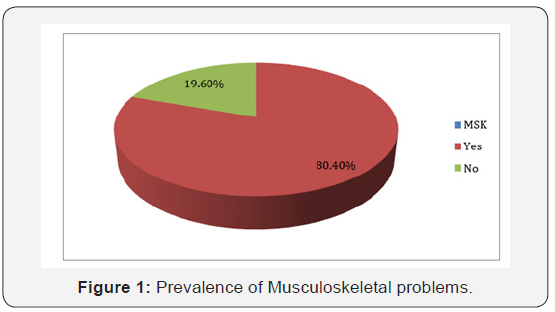
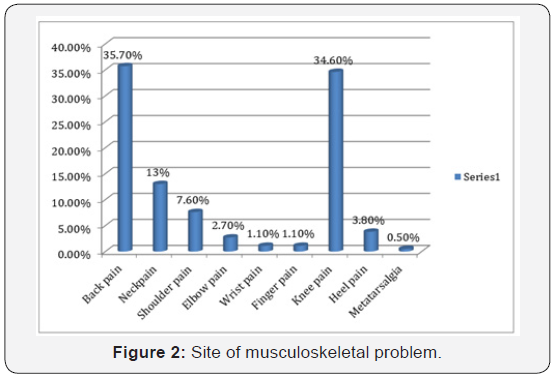
Average age of the respondents was 66.78±6.09 years. Majority of the subjects (83.9%) belonged to 60-70 years and 13.9% belonged to 71-80 years (Table 1). Majority of the respondents (43.9%) completed primary level education followed by SSC 12.2%, HSC 8.7%, graduate 4.8% and post-graduate 4.3%. Illiterate was 26.1% (Table 2). Housewife, service and business were 34.3%, 8.7% and 39.6%. About 17.4% subjects did different types of activities (Table 3). About 80.40% subjects suffered from musculoskeletal problems and 19.60% did not have (Figure 1). Back pain and knee pain were prominent i.e. 35.70% and 34.60%. Neck pain, shoulder pain, elbow pain and heel pain were seen among 13%, 7.60%, 2.70% and 3.80% respondents (Figure 2). About 47% suffered from chronic pain followed by sub-acute 32.40% and acute 20.50% (Figure 3). No statistically significant association was found between age group and musculoskeletal problem (Table 4).
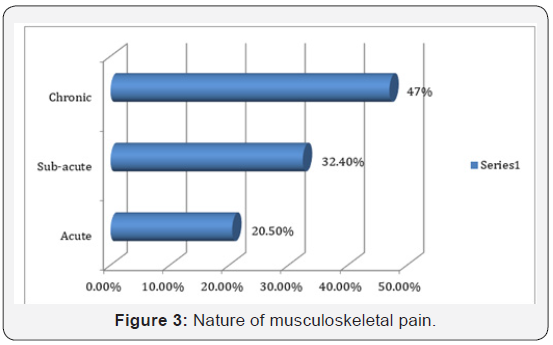
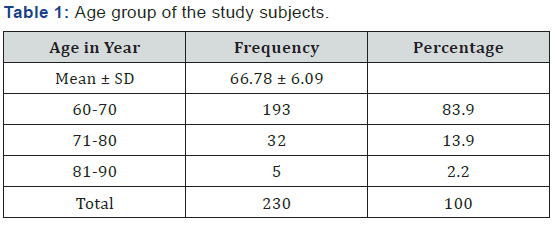
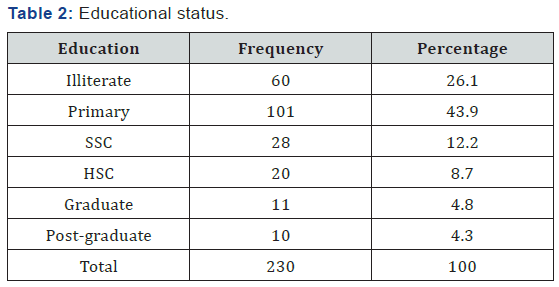

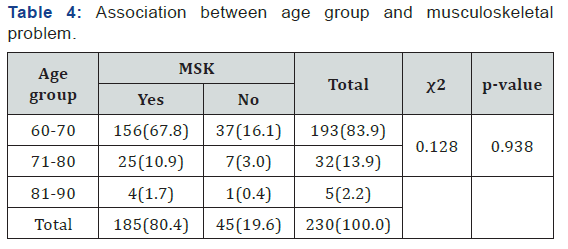
Discussion
Aged people are a burning issue now. Their health status is talkative matter and new challenge for us. Musculoskeletal disorders are common problems affecting the elderly. With age, musculoskeletal tissues show increased bone fragility, loss of cartilage resilience, reduced ligament elasticity, loss of muscular strength, and fat redistribution decreasing the ability of the tissues to carry out their normal functions. The loss of mobility and physical independence resulting from arthropathies and fractures can be particularly devastating in this population, not just physically and psychologically, but also in terms of increased mortality rates. This study was an initiative to explore prevalence of musculoskeletal symptoms among ethnic senior group in Rangamati hilly district of Bangladesh. It is reasonable to equate this practice based study with the population, because the great majority of people from ethnic minority communities are known to be registered with primary care practices [5]. Joint pain lasting for more than one month in the past month were slightly more prevalent among ethnic minorities.
The present study found that back pain and knee pain was prominent i.e. 35.70% and 34.60%. Neck pain, shoulder pain, elbow pain and heel pain were seen among 13%, 7.60%, 2.70% and 3.80% respondents. Few studies of the prevalence of musculoskeletal symptoms among ethnic minority populations in the UK have been published. Comparison is possible with results from other countries, although methodology and case definitions differ, and the focus of some studies has been radiological abnormality rather than symptoms. Brenner et al. [5] noted similar prevalence of radiological osteoarthritis between a white British population and one from rural Jamaica, although they reported that symptoms and incapacity were lower among Jamaicans [6]. Gibson et al. [6] found similar levels of joint disease in Pakistan and in white European populations [7]. In the USA, levels of self-reported arthritis have been found to vary little by ethnicity [8] and musculoskeletal disability was similar in African American and white populations [9]. A telephone study of acute back pain in North Carolina, USA, found a slightly lower prevalence in non-white subjects [10].
My results are compatible with these studies in that we have shown only small differences in overall pain prevalence between ethnic minority and white populations. As far as we know, our finding of markedly increased prevalence of “pain in most joints” has not previously been reported. The difficulties associated with any study of this type mean that some caution must be expressed. Extrapolation outside the four ethnic groups studied is not possible. The response rate was far higher among south Asian subjects than among the African Caribbean community and, inevitably, the sample sizes in most age-sex groups were small, given the population age structure of ethnic minorities in the UK. There was good equivalence between interviews and questionnaires. Precise estimates of the effects of the administration method used and non-response were not possible, but there was no evidence of large systematic differences that might have altered prevalence estimates or odds ratios greatly. Also, case note analysis showed that responders and non-responders had a reasonably similar profile. We have used responders as the denominator population for prevalence estimates and so assumed that responders and non-responders had a similar prevalence of pain.
I might have used the entire study group as the denominator, assuming that non-responders had no pain, but because pain prevalence between responders and non-responders appears similar, this would have underestimated the overall pain prevalence. However, it is still possible that there were some systematic differences between the different samples. Self reported pain is likely to have major cultural influences, but it is the symptoms that are presented in clinical consultations and differences in symptomatology which are worthy of note, even if the underlying objective morbidity is similar. Using the Townsend score to represent socioeconomic deprivation has limitations and other socioeconomic factors may contribute to the results. However, despite its limitations, this study presents important evidence of clinically significant differences among ethnic groups. Further research examining other ethnic minority populations in other locations would be valuable. It would also be of great interest to look more closely at the relation between symptoms and objective measures of morbidity, and at the phenomenon of widespread musculoskeletal pain among people from ethnic minority communities. There are several possible explanations for the differences in pain reporting by different ethnic groups. These include pain thresholds and the experience of pain, the effect of change of culture and migration, and mental health issues. Widespread pain might, for example, be an indication of mental distress and, possibly, migration, rather than ethnicity, is a key factor.
A review of published reports of these issues has recently been carried out with an emphasis on South Asian subjects [11]. The authors of the review call for further work to investigate the extent and nature of musculoskeletal disease among ethnic minorities. The present study has made a contribution to a study of this issue, but further work is needed to assess specific healthcare needs, whether or not the actual needs are for musculoskeletal care, and then to deal with those needs. Arthritis prevalence was significantly higher among respondents aged 45 years or older, women, obese respondents, and respondents with less education. Differences in this prevalence were observed among the 6 racial/ethnic groups. The prevalence of arthritis was significantly lower among Hispanics and API than among whites and significantly higher among AI/AN. The prevalence of activity limitation, work limitation, and severe joint pain were significantly higher among blacks, Hispanics, and MRO than among whites. Reasons for racial/ethnic differences are unknown and merit further investigation. They may be related to health care access, use of health care services, language barriers [12], differences in the prevalence of risk factors for arthritis and related disability (e.g., obesity, physically demanding jobs), and cultural differences in the understanding of survey questions, willingness to report limitation and pain, and variations in patterns of medication use and self management approaches to manage pain. There was a significant association between education and knee OA. No association was found between gender and OA in the adult population, whereas in the elderly population there was a significant association between female gender and OA [13]. The present study showed that no statistical association between age group, gender and musculoskeletal problems.
Conclusion
Musculoskeletal disorders are among the most common problems affecting the elderly. The resulting loss of mobility and physical independence can be particularly devastating in this population. About 80.40% subjects suffered from musculoskeletal problems and 19.60% did not have. Back pain and knee pain were prominent i.e. 35.70% and 34.60%. No statistically significant association was found between age group and musculoskeletal problem.
References
- Lee KS, Owen RE, Choo PW, Jayaratnam FJ (1991) The physiology of ageing. Singapore Med J 32(2): 159-160.
- Hossain MR (2005) Aging in Bangladesh and its population projections. Pakistan Journal of Social Sciences 3(1): 62-67.
- United Nations DoEaSA (2010) World Population Ageing 2009. New York, United States.
- World Health Organization (2002) Active Ageing - A Policy Framework. Geneva.
- Brenner JM, Lawrence JS, Miall WE (1968) Degenerative joint disease in a Jamaican rural population. Ann Rheum Dis 27: 326-332.
- Gibson T, Hameed K, Kadir M, Sultana S, Fatima Z (1996) Knee pain amongst the poor and affluent in Pakistan. Br J Rheumatol 35(2): 146-149.
- Jordan JM, Luta G, Renner JB, Dragomir A, Hochberg MC, et al. (1996) Ethnic differences in self-reported functional status in the rural south. The Johnston county osteoarthritis project. Arthritis Care Res 9: 483-491.
- Carey TS, Evans AT, Hadler NM, Lieberman G, Kalsbeek WD, et al. (1996) Acute severe low back pain. A population-based study of prevalence and care-seeking. Spine 21: 339-340.
- Njobvu P, Hunt I, Pope D, Macfarlane G (1999) Pain amongst ethnic minority groups of south Asian origin in the United Kingdom: a review. Rheumatology (Oxford) 38: 1184-1187.
- Escalante A, del Rincon I (2001) Epidemiology and impact of rheumatic disorders in the United States Hispanic population. Curr Opin Rheumato 13(2):104-110.
- Zhang W, Doherty M, Peat G, Bierma-Zeinstra MA, Arden NK, et al. (2010) EULAR evidence-based recommendations for the diagnosis of knee osteoarthritis. Ann Rheum Dis 69(3):483-489.
- Dracoglu D, Aydin R, Baskent A, Celik A (2005) Effects of kinesthesia and balance exercises in knee osteoarthritis. J Clin Rheumatol 11: 303-310.
- Bennell K, Hinman R (2005) Exercise as a treatment for osteoarthritis. Curr Opin Rheumatol 17(5): 634-640.






























